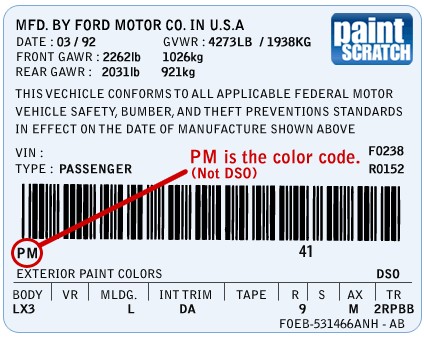Finding the correct touch up paint for your Ford can seem daunting, but knowing where to locate your Ford paint code, like 300012c, simplifies the process. This guide will help you understand Ford’s paint code system, locate your code, and choose the right touch up paint products for a seamless repair. Understanding your Ford’s paint code, whether it’s a common one like 300012C or a less frequent code, is crucial for a perfect match.
Decoding Your Ford Paint Code: Where to Find It
Ford generally places the paint code on the driver’s side door jamb. The code typically consists of two characters – letters or numbers – like “PM” or potentially “WA”. While 300012C isn’t a standard two-digit Ford code, it might represent a specific color formulation used by the manufacturer or a third-party paint supplier. Let’s explore how to find your two-digit code. Look for a label or sticker on the door jamb. The paint code is often listed alongside other vehicle information.
 Ford Color Code LocationFord Color Code on Driver’s Side Door Jamb
Ford Color Code LocationFord Color Code on Driver’s Side Door Jamb
Understanding Ford Paint Code Variations
While most Ford paint codes are two digits, there can be variations. Sometimes, you’ll see a longer alphanumeric code, such as PM/M6599, where “PM” is the primary color code and “M6599” may represent a specific formula or variant. If you encounter a code like 300012C, it’s best to cross-reference it with a Ford dealer or a reputable automotive paint supplier to confirm the exact color.
Ford Touch Up Paint: Repairing Scratches and Chips
Once you have identified your Ford paint code, selecting the right touch up paint is crucial for a professional-looking repair. For minor scratches and chips, Ford touch up paint pens offer precise application. Larger areas may benefit from Ford spray paint for even coverage.
Step-by-Step Guide to Using Ford Touch Up Paint
-
Preparation: Clean the damaged area with soap and water, and then use a wax and grease remover. Mask off the surrounding area with tape to protect the undamaged paint.
-
Rust Removal: If there is rust, remove it with sandpaper or a wire brush. Apply rust converter to the affected area.
-
Priming: For unpainted surfaces like bare metal or plastic, apply primer before the touch up paint. Allow the primer to dry thoroughly and lightly sand it.
-
Applying Touch Up Paint: Apply several thin coats of Ford touch up paint, allowing each coat to dry before applying the next.
-
Clearcoat Application: Once the touch up paint is dry, apply several thin coats of clearcoat for protection and shine.
-
Finishing: After the clearcoat dries for at least three days, use rubbing compound to smooth the repaired area and buff to a high gloss.
Choosing the Right Ford Touch Up Paint Product
-
Touch Up Paint Pens: Ideal for small scratches and chips, offering precise application and minimizing waste.
-
Spray Paint: Suitable for larger areas, ensuring even coverage and a professional finish.
Remember, a successful touch up paint repair depends on accurate color matching. If you’re unsure about your Ford’s paint code or need help selecting the right product, consult a professional or a reputable automotive paint supplier. Don’t let minor scratches diminish your Ford’s appearance. With the right touch up paint and proper application, you can restore your car’s finish to its original beauty.
